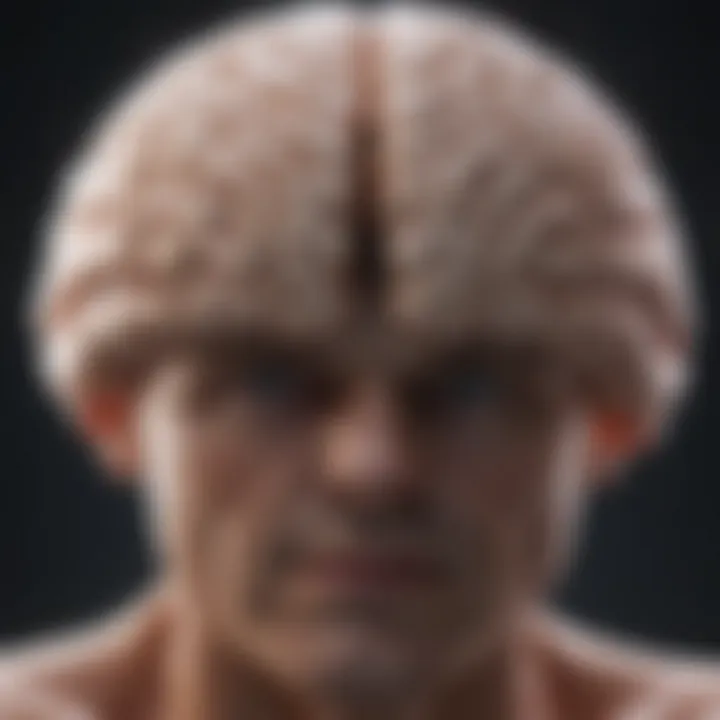NMO Disease Versus MS: In-Depth Comparative Study


Intro
Neuromyelitis Optica (NMO) and Multiple Sclerosis (MS) are two complex neurological disorders that often lead to confusion regarding their similarities and differences. Both conditions affect the central nervous system and present with overlapping symptoms, yet they possess unique characteristics that are crucial for precise diagnosis and treatment. The subsequent sections of this article will delve into each condition, laying a foundation for understanding their individual impact on patients and the healthcare system.
Article Overview
Purpose of the Article
This article aims to dissect the fundamental distinctions between NMO and MS, providing detailed insights into their symptoms, diagnostic criteria, and treatment options. A clear understanding of these differences can aid clinicians and researchers to enhance patient care and potentially influence therapeutic strategies. By illuminating the pathophysiological aspects and the tools available for diagnosis, this discourse seeks to promote informed discussions within healthcare fields.
Relevance to Multiple Disciplines
Exploring NMO and MS extends beyond neurology alone. The insights can impact fields such as psychology, rehabilitation, and even nursing. For psychiatric professionals, recognizing the psychological effects of these diseases is essential in managing patient care. Rehabilitation specialists might focus on the motor aspects that stem from either condition, while nursing staff must understand the unique needs of patients according to their specific diagnosis.
Research Background
Historical Context
NMO was once considered a subtype of MS until research in the early 21st century established it as a distinct disorder. Understanding these distinctions necessitates a look into how diagnostic practices have evolved. Initial misconceptions have spurred significant research and advancements in diagnostic technologies, particularly in the identification of aquaporin-4 antibodies, which are pivotal in distinguishing NMO from MS.
Key Concepts and Definitions
- Neuromyelitis Optica: An autoimmune condition primarily affecting the optic nerves and spinal cord, characterized by its severe symptoms, including vision loss and paralysis.
- Multiple Sclerosis: A chronic disease of the central nervous system that affects nerve signaling, leading to a variety of symptoms, including fatigue, mobility issues, and cognitive dysfunction.
Understanding the key differences between NMO and MS is crucial for timely diagnosis and effective management, influencing patient quality of life significantly.
Understanding the key differences between NMO and MS is crucial for timely diagnosis and effective management, influencing patient quality of life significantly.
This comprehensive analysis not only highlights clinical aspects but also discusses implications for patients’ everyday lives, fostering a nuanced understanding of both conditions.
Preface to NMO and MS
Understanding Neuromyelitis Optica (NMO) and Multiple Sclerosis (MS) is crucial for various stakeholders in the medical field, from researchers to practicing clinicians. Both conditions affect the central nervous system, but their underlying mechanisms, symptoms, and treatment strategies differ significantly. A thorough examination of these differences can provide valuable insights, as misdiagnosis can lead to inappropriate treatments and worsen patient outcomes.
By delving into NMO and MS, healthcare professionals can refine their diagnostic criteria and improve patient care. Improved understanding facilitates early diagnosis, which is critical in minimizing long-term disability. This section also paves the way for a holistic view of management strategies that can enhance quality of life for patients.
Overview of conditions
Neuromyelitis Optica, often referred to as Devic's disease, is characterized by the presence of aquaporin-4 antibodies. This autoimmune disorder primarily affects the optic nerves and spinal cord. Patients typically present with sudden vision loss and severe neurologic impairment. In contrast, Multiple Sclerosis is a chronic disease that presents with a diverse range of symptoms due to the damage of the myelin sheath covering neurons. MS can lead to long-lasting disabilities, and its symptoms can vary widely from person to person.
The clinical trajectories of NMO and MS are unique. NMO has a relapsing pattern with significant incidents occurring before the diagnosis is confirmed, often resulting in acute attacks. MS can also have relapsing forms but tends to present with more gradual onset of symptoms or chronic issues over time.
Significance of the comparison
Comparing NMO and MS is not just an academic exercise; it has real-world implications for patients. Understanding the nuances between these two conditions helps in crafting appropriate treatment plans. For example, therapies that are effective for MS may not be suitable for NMO and vice-versa.
Being able to distinguish between NMO and MS can drastically change the management and outcome of the patient's health journey.
Being able to distinguish between NMO and MS can drastically change the management and outcome of the patient's health journey.
Furthermore, this comparison sheds light on common misconceptions within both the public and the medical community. Heightened awareness can lead to better prognosis through accurate diagnoses. Ultimately, adopting a comparative approach deepens the collective understanding of neurological diseases, fostering a framework for better therapeutic interventions and research directions.
Pathophysiology of NMO versus MS
Understanding the pathophysiology behind Neuromyelitis Optica (NMO) and Multiple Sclerosis (MS) is crucial in distinguishing these two distinct neurological disorders. Both conditions involve the immune system and result in damage to the central nervous system. However, their mechanisms, triggers, and overall impacts on the nervous system differ significantly. Exploring these differences can help healthcare professionals develop better diagnostic tools and treatment strategies. The pathology involved in these diseases provides insight into how they progress and how patients might respond to various therapies.
Immune system involvement
The immune system plays a key role in both NMO and MS. In NMO, the immune response is predominantly orchestrated against the aquaporin-4, a water channel protein found in the astrocytes of the central nervous system. This autoimmune attack leads to inflammation and demyelination primarily in areas of the optic nerves and spinal cord. Patients may experience episodes of severe neurological symptoms, indicating acute attacks.
In contrast, MS involves a broader autoimmune response where the immune system mistakenly attacks the myelin sheath that protects nerve fibers. The immune cells, particularly T-cells and B-cells, cross the blood-brain barrier, triggering an inflammatory process. This results in the formation of lesions in various areas of the brain and spinal cord. The pattern of immune involvement differentiates the two diseases significantly and affects the types of therapies that may be appropriate.
Nerve damage mechanisms
Nerve damage in NMO primarily results from acute inflammation leading to direct destruction of astrocytes and related structures. This mechanism can cause severe episodes, including vision loss and paralysis. Unlike NMO, MS is more insidious, with symptoms that arise from chronic inflammation and damage. In MS, the destruction of myelin leads to slower transmission of electrical impulses along the nerves, resulting in a variety of neurological symptoms that may fluctuate or persist over time.
Both conditions ultimately lead to neuronal damage, but the pathways and rates of damage differ. Understanding these mechanisms sheds light on why certain treatments are more effective for one disorder compared to the other.


Environmental factors
Environmental factors contribute to the pathophysiology of both NMO and MS. Research suggests that geographic location may play a role. For instance, MS has higher prevalence in regions further from the equator, which might be linked to vitamin D deficiency and exposure to sunlight. Meanwhile, NMO has been associated with specific genetic factors and may also relate to environmental triggers, such as infections that may provoke immune responses.
Moreover, lifestyle factors, such as smoking, have been indicated to elevate the risk of developing MS. Understanding these environmental influences is essential for developing preventative strategies and tailored therapies for individuals at risk or living with these diseases.
"Pathophysiology is not just about 'what occurs' but also about the underlying causes that drive these neurological conditions to manifest in patients."
"Pathophysiology is not just about 'what occurs' but also about the underlying causes that drive these neurological conditions to manifest in patients."
Symptoms and Clinical Presentation
Understanding the symptoms and clinical presentation of Neuromyelitis Optica (NMO) and Multiple Sclerosis (MS) is crucial in the discourse surrounding these two conditions. Comparing the symptoms can significantly aid in the diagnostic process. Each disease presents a unique set of challenges and implications for patient care. Recognizing these patterns is vital for timely intervention and appropriate treatment strategies. Highlighting the differences and similarities in clinical manifestations can enhance the awareness of both medical professionals and patients. This section will outline the common symptoms of each condition, as well as a comparative analysis of these symptoms.
Common symptoms of NMO
Neuromyelitis Optica often presents with specific and severe symptoms. The most prominent symptoms include:
- Visual disturbances: Many patients experience sudden vision loss or blurring due to optic neuritis.
- Neurological deficits: This can manifest as weakness or paralysis, usually affecting the legs more than the arms.
- Sensory issues: Altered sensations, like numbness or tingling, are frequently reported.
- Bowel and bladder dysfunction: These issues can also arise, treating this area can be quite challenging for patients.
In NMO, the symptoms may appear suddenly and can escalate quickly. This fast progression often necessitates immediate medical attention. The health care provider's ability to identify these specific symptoms is essential for an accurate diagnosis.
Typical symptoms of MS
Multiple Sclerosis displays a diverse array of symptoms that tend to vary from person to person. Some common symptoms include:
- Fatigue: This is one of the most prevalent complaints among MS patients, often affecting daily life.
- Cognitive changes: Issues such as memory loss or difficulty concentrating are frequent.
- Motor symptoms: Weakness or spasms may occur, particularly in the lower extremities.
- Vision problems: Similar to NMO, optic neuritis can also happen in MS, leading to blurred or lost vision.
Symptoms in MS can come and go, a fluctuating pattern called relapses. Understanding this can help establish a treatment plan and manage patient expectations.
Comparative symptom analysis
When contrasting symptoms of NMO and MS, certain areas of overlap and distinction emerge. For example, both diseases can lead to visual impairment, but the context and progression differ significantly. In NMO, optic neuritis may lead to complete vision loss swiftly, while in MS, it tends to be more variable.
Moreover, the speed of symptom onset is markedly different. NMO may cause rapid neurological deterioration, while MS has a relapsing-remitting pattern. This distinction affects how each condition is perceived by both patients and healthcare providers.
Both conditions result in profound implications for patient quality of life. Tracking and analyzing symptoms can be key in managing care.
Understanding the unique symptoms of NMO and MS is vital for accurate diagnosis and effective treatment.
Understanding the unique symptoms of NMO and MS is vital for accurate diagnosis and effective treatment.
Diagnosis: Methodologies and Challenges
In the domain of Neuromyelitis Optica (NMO) and Multiple Sclerosis (MS), accurate diagnosis is crucial for determining appropriate treatment and management strategies. The complexity inherent in these neurological disorders often leads to challenges that can complicate the diagnostic process. Understanding the methodologies and challenges facilitates better outcomes for patients and improves the overall efficiency in the clinical setting. Both conditions present overlapping symptoms yet differ significantly in etiology and treatment needs, which makes precise diagnosis essential.
Diagnostic criteria for NMO
NMO's diagnostic criteria revolve around the identification of specific clinical features and biomarkers. The 2015 criteria from the International Panel on NMO Diagnosis serve as a framework.
Key diagnostic elements include:
- Clinical attacks: At least one episode of optic neuritis or acute myelitis.
- Aquaporin-4 antibodies: The presence of these antibodies is a significant indicator.
- MRI findings: Imaging should reveal characteristic lesions in the optic nerves or spinal cord.
These criteria allow for a streamlined process, ensuring that patients get the correct diagnosis promptly. However, misdiagnosis can occur, particularly when clinicians are less familiar with NMO. The knowledge here is power for practitioners.
Diagnostic protocols for MS
The diagnostic protocols for MS require a multifaceted approach. The McDonald criteria, established in 2017, are the primary guideline in diagnosing MS, focusing on dissemination in time and space of neurological lesions.
Elements of the diagnostic protocol include:
- Clinical history: A thorough patient history is essential.
- Neurological examination: A detailed evaluation of neurological function is performed.
- MRI scans: These identify lesions typical of MS, located in different parts of the central nervous system.
- Cerebrospinal fluid analysis: This may show the presence of oligoclonal bands, contributing to the diagnostic confirmation.
Using these protocols, clinicians can discern MS from other diseases, guiding appropriate management and therapeutic measures.
Differential diagnosis considerations
Differential diagnosis involves considering alternative conditions that can present similarly to NMO and MS symptoms. It is imperative to look beyond the apparent, as many patients may have overlapping features with disorders such as neuromyelitis optica spectrum disorder (NMOSD), transverse myelitis, or other autoimmune diseases.


Important considerations include:
- Symptom overlap: Fatigue, weakness, and sensory changes can also manifest in other conditions.
- Diagnostic imaging: Radiological investigations can sometimes yield ambiguous results.
- Laboratory tests: Other antibody tests and CSF analysis might reveal additional clues.
Clinicians must carefully evaluate the whole clinical picture rather than relying solely on initial guiding criteria. Engaging cross-disciplinary models can enhance diagnostic accuracy.
Accurate diagnosis can redefine treatment pathways and lead to improved patient outcomes.
Accurate diagnosis can redefine treatment pathways and lead to improved patient outcomes.
Biomarkers in NMO and MS
Biomarkers play a crucial role in understanding and differentiating between Neuromyelitis Optica (NMO) and Multiple Sclerosis (MS). Their significance lies not only in aiding diagnosis but also in guiding treatment and understanding disease progression.
Role of Aquaporin-4 in NMO
Aquaporin-4 is a water channel protein that has gained attention as a key biomarker for NMO. The immune system of individuals with NMO often targets this protein, leading to severe inflammation and damage to the optic nerves and spinal cord. Testing for antibodies against Aquaporin-4 can provide direct evidence of the disease. It is estimated that around 70-80% of NMO patients test positive for these antibodies. The presence of these antibodies can facilitate early diagnosis and differentiation from MS. Furthermore, monitoring these biomarkers can help assess the effectiveness of treatment strategies and track disease activity over time.
Multiple Sclerosis biomarkers
In contrast, MS has a broader spectrum of biomarkers. Notably, the presence of oligoclonal bands in cerebrospinal fluid is often used in MS diagnosis. These bands indicate abnormalities in the immune system's response and are found in many patients with MS. Other biomarkers include neurofilament light chain and myelin basic protein, which are associated with neuronal damage and inflammation. Identifying and tracking these biomarkers can help clinicians understand disease severity and predict disease progression. The variability in biomarkers present in MS reflects its heterogeneous nature, making precise diagnosis and treatment planning more complex compared to NMO.
Emerging biomarkers in research
Ongoing research continues to uncover promising biomarkers that have the potential to revolutionize the management of both NMO and MS. For instance, investigations into the role of gut microbiota in influencing immune responses are gaining traction. Findings suggest that gut health might correlate with neurological diseases, offering a potential interventional target. Additionally, advancements in imaging techniques have allowed for better visualization of biomarkers related to myelin integrity and axonal damage. These developments could enable earlier diagnosis and contribute to more personalized treatment approaches. The exploration of these emerging biomarkers could provide deeper insights into the pathophysiology of both conditions and may lead to improved patient outcomes down the road.
"The future of biomarker research in neurological diseases promises enhanced diagnostic accuracy and targeted therapies, enhancing the quality of life for affected individuals."
"The future of biomarker research in neurological diseases promises enhanced diagnostic accuracy and targeted therapies, enhancing the quality of life for affected individuals."
Understanding biomarkers in NMO and MS not only sheds light on disease mechanisms but also offers hope for better management techniques and potentially novel treatment options.
Management and Treatment Strategies
Management and treatment strategies for Neuromyelitis Optica (NMO) and Multiple Sclerosis (MS) significantly influence patients’ quality of life and overall prognosis. Understanding these strategies helps in better patient care and encourages informed discussions among healthcare professionals. Both conditions, while distinct in their pathophysiology and clinical manifestations, require tailored approaches for effective management. This section will delve into the current treatments available for NMO, examine standard therapies for MS, and conduct a comparative analysis of the efficacy of these treatments.
Current treatments for NMO
Treatment for NMO primarily focuses on mitigating acute attacks and preventing relapses. The use of steroids is common during acute episodes. For longstanding management, medications like Azathioprine, Mycophenolate mofetil, or Rituximab often come into play. These agents aim to suppress the immune response, reducing the frequency and severity of flare-ups. Early intervention is crucial. Research shows that prompt treatment can lead to significant improvement in long-term outcomes.
Some ongoing studies are exploring the efficacy of additional immunotherapies. Eculizumab, a monoclonal antibody, is one option under investigation. It works by inhibiting the complement system, which is implicated in NMO's pathophysiology. While some patients respond well to these therapies, others may experience varied results. Regular monitoring and assessments are essential to tailor treatments to individual needs.
Standard therapies for MS
Multiple Sclerosis management encompasses a broader spectrum due to its heterogeneous nature. First-line treatments often include interferon beta and glatiramer acetate, which help modulate the immune response and reduce relapse rates. More advanced therapies, such as Natalizumab or Ocrelizumab, are indicated for patients with more severe forms of MS who do not respond well to first-line therapies.
In addition, symptomatic treatments are available to help mitigate symptoms like fatigue, pain, and spasticity. Medications like Baclofen for muscle spasticity and Modafinil for fatigue can improve the overall quality of life. The goal of treatment is not only to manage relapses and progression but also enhance the patients’ ability to function daily.
Comparative efficacy of treatments
In comparing treatments for NMO and MS, it’s clear that both fields have made significant progress. However, the strategies differ in their focus and mechanisms. NMO treatments often target acute episodes and prevention through immune suppression. Conversely, MS treatments are more varied, addressing not just relapses but also progression and symptomatic relief.
A few key points to consider include:
- Efficacy: While both conditions respond to immunosuppressive therapies, NMO treatments may offer rapid stabilization during flare-ups, while MS therapies emphasize long-term management strategies.
- Side effects: Side effects can also vary between the two conditions. NMO treatments may result in significant immunosuppression, leading to increased risks of infections. MS therapies may result in different side effects related to specific drugs used, which necessitates careful monitoring.
Both conditions showcase the need for a personalized approach in treatment, considering individual patient responses and preferences. As further research unfolds, treatment options are expected to expand, improving outcomes for patients with both NMO and MS.
Both conditions showcase the need for a personalized approach in treatment, considering individual patient responses and preferences. As further research unfolds, treatment options are expected to expand, improving outcomes for patients with both NMO and MS.
Quality of Life Considerations
Understanding the quality of life for individuals with Neuromyelitis Optica (NMO) and Multiple Sclerosis (MS) is crucial. It encompasses the physical, emotional, and social aspects of life influenced by these conditions. The impact on daily activities, the ability to work, and overall well-being can vary considerably among patients. Evaluating quality of life helps highlight the clinical significance of these diseases and informs treatment strategies to improve patient outcomes.
Impact of NMO on lifestyle
NMO can lead to substantial changes in lifestyle for those affected. This condition often causes severe symptoms, including vision loss and difficulties in mobility. As the symptoms can flare up unpredictably, many individuals find it challenging to maintain active employment.
Limited physical capabilities result in necessary adjustments in daily routines. Simple tasks may become strenuous, affecting independence. Daily activities like household chores or socializing require more planning and support. This change can foster feelings of isolation and frustration.


Moreover, the physical limitations associated with NMO can directly affect mental health. Managing fatigue and coping with unpredictable symptom exacerbations can lead to increased anxiety or depression. Therefore, understanding this impact is essential to develop support systems that enhance patient resilience and mental well-being.
Quality of life in MS patients
In the context of MS, the quality of life often fluctuates due to the relapsing-remitting nature of the disease. Patients may lead relatively normal lives during periods of remission, but symptoms can resurface anytime. Common challenges include fatigue, mobility issues, and cognitive difficulties.
Patients often report feeling the need to adapt their living spaces and routines. This might involve modifications to the home environment, use of assistive devices, or lifestyle changes that prioritize energy conservation. Regular engagement in social and recreational activities is paramount, as it significantly contributes to emotional health despite the barriers presented by the disease.
When considering treatment options, physicians often assess their effectiveness not just based on symptom management but on the overall quality of life achieved. This multifaceted evaluation allows for a more personalized approach to care and rehabilitation, focusing on holistic patient well-being.
Comparative impact on mental health
Both NMO and MS have notable effects on mental health, but these impacts may present differently in patients. NMO patients may experience sharp declines in mental health due to immediate and severe symptoms, leading to less predictable trajectories. The lack of awareness and understanding of NMO can amplify feelings of anxiety in individuals, contributing to social withdrawal.
On the other hand, MS often engages patients in a longer battle with uncertainty regarding symptom management. Patients frequently face the psychological challenge of predicting future relapses. This uncertainty can result in chronic stress and related mental health issues such as depression.
In each case, caregivers and healthcare providers must address mental health as an integral part of treatment plans. Support groups, psychotherapeutic interventions, and open communication about mental health can be beneficial for both NMO and MS patients, fostering a more supportive environment for coping with their conditions.
"Managing NMO and MS requires a comprehensive approach that considers not just physical health but also mental and emotional aspects of the patient's life."
"Managing NMO and MS requires a comprehensive approach that considers not just physical health but also mental and emotional aspects of the patient's life."
Conclusively, assessing the quality of life in both NMO and MS provides important insights into the multifaceted challenges faced by patients. Care strategies must reflect these complexities to enhance life quality and emotional resilience.
Research Gaps and Future Directions
Understanding the distinctions between Neuromyelitis Optica (NMO) and Multiple Sclerosis (MS) is critical for both treatment efficacy and patient quality of life. The comparison reveals significant differences, yet many areas remain unexplored, indicating the pressing need for further research. Research gaps can lead to misdiagnosis and inappropriate treatment pathways. Future directions in research could enhance current knowledge, benefiting both clinicians and patients.
Ongoing research initiatives
Currently, various research initiatives focus on filling the gaps in our understanding of NMO and MS. Institutions worldwide are investigating the genetic factors that differentiate these diseases. Studies are also exploring the role of environmental triggers in both conditions. A particular focus is on how these triggers influence the immune response in NMO compared to MS. Clinical trials are underway to assess new medications aimed at mitigating symptoms and improving patient outcomes.
Several organizations, including the National Multiple Sclerosis Society, provide funding for research, promoting exploration in this area. Collaborative efforts between universities and healthcare institutions enhance the breadth and quality of investigations, fostering novel approaches to understanding these complex diseases.
Potential advancements in therapies
The horizon for potential advancements in therapies continues to expand. Research is now focusing on more targeted treatment options. For NMO, treatments like eculizumab have shown promise. It is an antibody that inhibits the immune response, offering hope for better control of the disease.
On the MS front, therapies such as ocrelizumab are gaining traction. This drug modifies the immune system and could change treatment paradigms significantly. Ongoing research is assessing the efficacy of combination therapies as well. There is also interest in developing personalized medicine approaches tailored to individual patient profiles, which could dramatically improve patient outcomes.
Future studies on biomarkers
Biomarkers play an instrumental role in distinguishing between NMO and MS. Research must focus on identifying new biomarkers that indicate disease progression or exacerbation. Future studies aim to validate the role of Aquaporin-4 in NMO and explore novel biomarkers for MS which could lead to improved diagnostic tests.
Understanding how biomarkers correlate with clinical outcomes will be crucial. This could allow for timely interventions and tailored treatment approaches. As the research progresses, collation of data across various studies will facilitate deeper insights into these diseases.
"Identifying biomarkers could transform current understanding and management of both NMO and MS, moving towards a future with improved precision in treatments."
"Identifying biomarkers could transform current understanding and management of both NMO and MS, moving towards a future with improved precision in treatments."
As the field evolves, continued collaboration among researchers, clinicians, and patients is vital. Engaging all stakeholders will help bridge current knowledge gaps and enhance therapeutic strategies moving forward.
Epilogue: Key Takeaways
Understanding the differences and similarities between Neuromyelitis Optica (NMO) and Multiple Sclerosis (MS) holds significant importance for medical professionals and researchers. This analysis provides critical insight into the pathophysiology, symptoms, diagnostic challenges, and treatment options that differentiate these two neurological conditions. By synthesizing this information, the article aims to clarify misconceptions and enhance informed discussions within healthcare settings.
Summary of findings
Several key points emerge from this comprehensive exploration. Firstly, NMO is primarily characterized by the destruction of myelin in the optic nerves and spinal cord, triggered by antibodies against Aquaporin-4. In contrast, MS shows a more widespread demyelination pattern with various immune-mediated triggers.
The symptoms also vary significantly between both conditions. While NMO often presents with acute episodes of vision loss and spinal cord lesions, MS features a broader array of symptoms, including fatigue, cognitive changes, and varied motor impairments.
The article has also highlighted the diagnostic hurdles faced by healthcare professionals. The overlapping symptoms can complicate accurate diagnosis, making awareness and the use of distinct diagnostic criteria critical. Biomarkers play a crucial role in differentiating these disorders, with ongoing research aimed at uncovering further nuances.
Implications for clinical practice
The implications of this analysis for clinical practice are profound. Understanding the unique attributes of NMO and MS allows for more accurate diagnoses and tailored treatment plans. It is essential for practitioners to remain vigilant about the evolving research landscape.
Adopting a comprehensive approach towards symptom management, including both pharmacologic and non-pharmacologic strategies, will enhance patient outcomes. Additionally, recognizing the different impacts on patients’ quality of life is vital for developing holistic treatment frameworks. This comparative understanding can lead to more personalized care, ultimately improving the journeys of those affected by these complex conditions.
"A differential diagnosis between NMO and MS is key to appropriate management and care strategies."
"A differential diagnosis between NMO and MS is key to appropriate management and care strategies."
Healthcare practitioners should continually educate themselves on developments in these diseases, engage in research, and participate in discussions that refine and advance the clinical understanding of NMO and MS.



